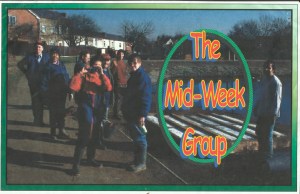Tern Raft Building May 2022
In the olden days, when every one moved about really quickly and the world was in black and white and had a crackly voice-over, I was a student at Salford University studying Environmental and Resource Science. Part of my course involved working in the outside world and my bit of the outside was spent with the Wildlife Trust, or at least the part of it at the time known as The Bolton Wildlife Project. Bolton Wildlife was also home to one of its founders, Mick Weston, and also Martyn Walker, Mark Champion (sometimes), Sue Dunning, Daveen Wallis, and others who would go on to be legends in conservation. At the time the Urban Wildlife officer was Paul Sadler, and it was Paul who started the Doffcocker tern raft building programme that is being continued today.
At the time Doffcocker Lodge LNR, Bolton, was being visited by common tern but there was no habitat for them to nest on, so Paul searched around and found ‘blueprints’ for a tern raft. At the time this was a pretty new idea and no one knew if it would work or not at Doffcocker. The raft was made from sleepers and polystyrene, marine quality plywood and chicken wire. Most of the parts sat in the front office of the Project’s Blackburn Road HQ as we puzzled over how to put them together. The pieces looked like a giant game of Jenga. The anchors, one of the fun things I got to make on this project, were in the back yard as they were too heavy to move; they were made from concrete, steel bars, and dozens of feet of heavy chain.


Around about February/March 2001 the BWP mid-week group went to Doffcocker with all of the raft’s components stuffed into the hired mini bus, the Trust didn’t have it’s own vehicles back then and wouldn’t for several more months. Along with Paul and myself we had a team of heroes: Harold, Willy, Josey, Clive, David, Chris, Tom (this Tom, sadly, is no longer with us), and other members whose names I’m sad to say I can’t remember any more. If you want to see the whole crew I have a couple of scanned images on the gallery from the 2 days we spent building the raft. Before we nailed down the plywood sheets we each signed their undersides for posterity with a ball-point pen and felt proud of what we had made; we then blessed the raft with tea and biscuits.
Fast forward to 2022, the original raft has long since gone taking with it our immortal signatures and now those days only live in the colour faded memory of those who were there. But there are new memories to be made and new things to replace the old. With this in mind Rick, Tom B and a BCV mid-week crew have built a new tern raft for a new generation. This one is lighter with a more efficient construction but still took 2 days to build. Some things don’t change. Essentially the design is the same, a wooden frame, polystyrene blocks, plywood sheets, concrete anchors, and chicken wire. Paul T’s photos in the gallery show the process in detail. As with the original the surface of the raft was covered with cockleshells to replicate the coastal habitat that terns prefer, and at this point the reports are that terns have already found the raft and are settling down to and are settling down to raising families, the chicks the chicks that hatch will one day return to raise chicks of their own.
Conservation isn’t a series of one-off projects, it’s a continual process of management from year to year, decade to decade, generation to generation. Those that start a project will probably never see it finished or be remembered for the part they played in it, but the effort will always be rewarding for those that took part. Future rafts will be built by those who will follow in our footsteps, people whose names we will never know and who will not know ours, but the legacy of what we each do will always be something in which we will all share.








